| This article needs additional citations for verification. Please help improve this article by adding citations to reliable sources. Unsourced material may be challenged and removed. Find sources: "Golestan Palace" – news · newspapers · books · scholar · JSTOR (January 2017) (Learn how and when to remove this message) |
| UNESCO World Heritage Site | |
|---|---|
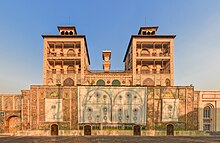 Edifice of the Sun (Shams-ol-Emareh) Edifice of the Sun (Shams-ol-Emareh) | |
| Location | Tehran, Iran |
| Criteria | Cultural: ii, iii, iv |
| Reference | 1422 |
| Inscription | 2013 (37th Session) |
| Area | 5.3 ha |
| Buffer zone | 26.2 ha |
| Coordinates | 35°40′47″N 51°25′13″E / 35.67972°N 51.42028°E / 35.67972; 51.42028 |
   | |
The Golestan Palace (Persian: کاخ گلستان, Kākh-e Golestān), also transliterated as the Gulistan Palace and sometimes translated as the Rose Garden Palace from Persian language, was built in the 16th century, renovated in the 18th century and finally rebuilt in 1865. It is the former official royal Qajar complex in Tehran.
One of the oldest historic monuments in the city of Tehran, and a UNESCO World Heritage Site, the Golestan Palace belongs to a group of royal buildings that were once enclosed within the mud-thatched walls of Tehran's arg ("citadel"). It consists of gardens, royal buildings, and collections of Iranian crafts and European gifts from the 18th and 19th centuries.
History

The origin of the Tehran's royal citadel can be traced back to July 6, 1404; when Ruy González de Clavijo, the envoy of Enrique III, traveled to Samarkand to meet with Timur, and he chose to stay at the house of Baba Sheikh (one of the elders of Tehran). It is believed that his house was located in the area of the royal citadel and later they were transformed into new buildings with changes. The beginning of the royal citadel can be traced back to the time of Suleiman I, with the construction of a palace in the Chenaristan area, a Divankhane where Soltan Hoseyn in the last year of his reign meet with the Ottoman government's ambassador, Ahmad Dari Effendi. Tehran's arg ("citadel") was built during the reign of Tahmasp I (r. 1524–1576) of the Safavid dynasty (1502–1736). Abbas the Great built a large garden in the northern part of the fence, which was later surrounded by a high wall and buildings were built, with the royal residence was built inside it. At the end of the Safavid era, Tehran was sometimes the temporary seat of the court of Safavid kings. The palace was later renovated by Karim Khan of the Zand dynasty (r. 1750–1779). Agha Mohammad Khan of the Qajar dynasty (1742–1797) chose Tehran as his capital. The arg became the seat of the Qajars (1794–1925). The court and palace of Golestan became the official residence of the Qajar dynasty. The palace was rebuilt to its current form in 1865 by Haji Ab ol Hasan Mimar Navai.
During the Pahlavi era (1925–1979), the Golestan Palace was used for formal receptions. The Pahlavi dynasty built their own palaces in the Niavaran and Sa'dabad palace complexes. The most important ceremonies held in the palace during the Pahlavi era were the coronations of Reza Shah in 1926 and Mohammad Reza Shah and Shahbanu Farah in 1967. In between 1925 and 1945, a large portion of the buildings of the complex were destroyed by the order of Reza Shah. He believed that centuries-old Qajar palaces should not hinder the growth of a modern city. In the place of the old buildings, commercial buildings with the modern style of 1950s and 1960s were erected.
Sites
The Golestan Palace Complex consists of 17 structures, including palaces, museums, and halls. Almost all of this complex was built during the 131 year rule of the Qajar dynasty. These palaces were used for many occasions such as coronations and other important celebrations. It also consists of three main archives, including the photographic archive, the library of manuscripts, and the archive of documents.
Marble Throne (Takht e Marmar)
Main article: Marble Throne
This terrace, known as the Marble Throne, was built in 1747-1751.
Karim Khani Nook (Khalvat e Karim Khani)
Dating back to 1759, this building was a part of the interior residence of Karim Khan of the Zand dynasty. The basic structure of the Karim Khani Nook is similar to the Marble Throne. Like the latter, it is a terrace. There is a small marble throne inside the terrace. The structure is much smaller than the Marble Throne and it has much less ornamentation. There was once a small pond with a fountain in the middle of this terrace. Water from a subterranean stream (the shah's qanat) flowed from the fountain into the pond and was later used to irrigate the palace grounds.
 Panoramic view of the Karim Khani Nook
Panoramic view of the Karim Khani Nook
Naser al-Din Shah Qajar was fond of this corner of the Golestan Palace.
Pond House (Howz Khaneh)

The Pond House was used as a summer chamber during the Qajar era. Works of European painters presented to the Qajar court are housed there.
Brilliant Hall (Talar e Brelian)

The Brilliant Hall was built by the order of Naser ed Din Shah. It is named so as it features brilliant mirror work done by Iranian artisans.
Containers' Hall (Talar e Zoruf)
This building replaced the building of Narenjestan in the north of the Ivory Hall (Talar e Adj).
Ivory Hall (Talar e Adj)
Ivory Hall is a large hall used as a dining room. It was decorated with some gifts presented to Naser ed Din Shah by European monarchs.
Mirror Hall (Talar e Aineh)

The Mirror Hall is a relatively small hall designed by Haj Abd ol Hossein Memar Bashi (Sanie ol Molk).
Salam Hall (Talar e Salam)

The Salam ("Reception") Hall was originally designed to be a museum.
Diamond Hall (Talar e Almas)
The Diamond Hall is located in the southern wing of the Golestan Palace, next to the Windcatcher Mansion.
The Windcatcher Mansion (Emarat e Badgir)
See also: Windcatcher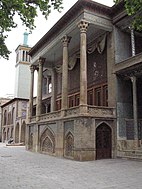 The Windcatcher Mansion
The Windcatcher Mansion One of the Windcatchers
One of the Windcatchers
The Windcatcher Mansion was constructed during the reign of Fath-Ali Shah Qajar. The building underwent major renovations, including structural changes, during the reign of Naser ed Din Shah.
Edifice of the Sun (Shams-ol-Emareh)

The Edifice of the Sun was designed by Moayer ol Mamalek. Construction on this building began in 1865 and was completed in two years. A clock presented by Queen Victoria to Naser al-Din Shah is mounted atop the building.
Museum of Gifts

This building is located under the Salam Hall.
Abyaz Palace
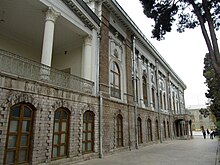
The Qajar monarch had the Abyaz Palace constructed.
Museum Hall
The original collection of the Museum Hall is now scattered among Tehran's many museums.
Photographic archive
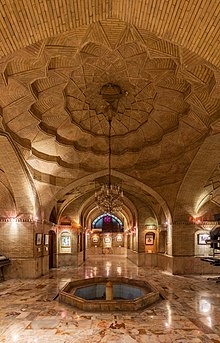
There is an early photographic collection at the Golestan complex which includes photos which are mainly related to the time of the 19th-century progress of photography in Europe. It was created by the order of Naser ed Din Shah. It is mentioned that "photography was so common at the royal palace that the king's wives and his servants also took pictures and posed playfully in front of the camera." There is a picture of one servant with flowers decorating his head and shoulders.
Present use
On 11 October 2005, the Cultural Heritage Organization of Iran submitted the palace to the UNESCO for inclusion into the World Heritage List in 2007. On 23 June 2013, it was proclaimed as world heritage site during the UNESCO meeting in Phnom Penh.
The Golestan Palace is currently operated by the Cultural Heritage Organization of Iran.
Gallery
-
 The Windcatcher Mansion
The Windcatcher Mansion
-
 Karim Khani Nook
Karim Khani Nook
-
 Stairs leading up to the Salam Hall
Stairs leading up to the Salam Hall
-
 The ceiling of the Windcatcher Mansion
The ceiling of the Windcatcher Mansion
-
 A pool
A pool
-
 The Marble Throne
The Marble Throne
-
 Tomb of Naser al-Din Shah Qajar
Tomb of Naser al-Din Shah Qajar
-
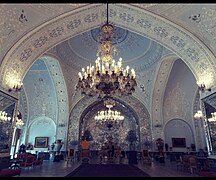 The ceiling of Salam Hall
The ceiling of Salam Hall
-
 Tilings 1
Tilings 1
-
 Tilings 2
Tilings 2
-
 Tilings 3
Tilings 3
-
 Tilings 4
Tilings 4
-
 Tilings 5
Tilings 5
-
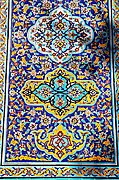 Tilings 6
Tilings 6
-
 Tilings on the walls
Tilings on the walls
-
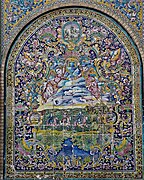 Tilings 7
Tilings 7
-
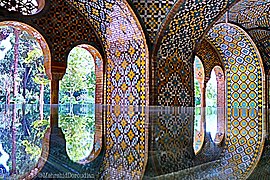 Tilings on the Karim Khani Nook
Tilings on the Karim Khani Nook
-
 Tilings on the palace
Tilings on the palace
-
 Tilings 8
Tilings 8
-
 Tilings on the Shams-ol-Emareh palace
Tilings on the Shams-ol-Emareh palace
-
 Tilings 9
Tilings 9
-
 The Ivory Hall (Talar e Adj)
The Ivory Hall (Talar e Adj)
-
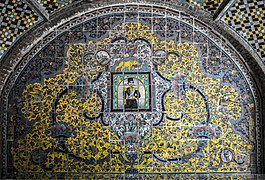 Tilings in the Karim Khani Nook
Tilings in the Karim Khani Nook
-
 The map of Golestan Palace
The map of Golestan Palace
-
 Containers' Hall (Talar e Zoruf)
Containers' Hall (Talar e Zoruf)
-
 The Salam Hall
The Salam Hall
-
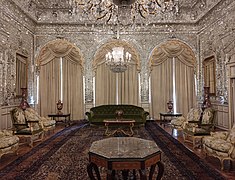 The Mirror Hall (Talar e Aineh)
The Mirror Hall (Talar e Aineh)
-
 Museum Hall
Museum Hall
-
 Naser al-Din Shah on the steps of the Sun Throne at the Mirror Hall
Naser al-Din Shah on the steps of the Sun Throne at the Mirror Hall
-
 Stone inscription of the Brilliant Hall from the reign of Mozaffar ad-Din Shah Qajar
Stone inscription of the Brilliant Hall from the reign of Mozaffar ad-Din Shah Qajar
-
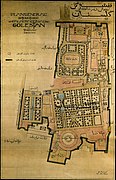 The map of Golestan palace, 1931
The map of Golestan palace, 1931
-
 The crown of Agha Mohammad Khan Qajar
The crown of Agha Mohammad Khan Qajar
-
 The tilings of the Museum Mansion
The tilings of the Museum Mansion
See also
References
- ^ G. Massiot & cie. "Gulistan Palace: Part of the palace complex with water garden". Curate ND. Retrieved 2021-06-29.
- Iran Traveling Center (July 5, 2014). "The Palace of Roses in Golestan Palace Tehran Iran". Facebook. Archived from the original on 2022-02-26. Retrieved 2021-06-29.
- ^ "Golestan Palace". UNESCO World Heritage Centre. Retrieved 2017-01-02.
- "گشتی در کاخ گلستان | خلوت باشکوه پادشاهان - مجله گردشگری اتاقک" (in Persian). Retrieved 2023-12-25.
- ^ "در مورد کاخ گلستان در ویکی تابناک بیشتر بخوانید". tabnak.ir. Retrieved 2023-12-25.
- تهران, آژانس عکس. "کاخ گلستان". آژانس عکس تهران (in Persian). Retrieved 2023-12-25.
- vista. "تهران در عصر صفوی". ویستا (in Persian). Retrieved 2023-12-25.
- "کاخ گلستان > موزه های کاخ". www.golestanpalace.ir. Retrieved 2023-12-25.
- "Tehran, Iran - Image of the Week - Earth Watching". earth.esa.int. Retrieved 2023-12-25.
- "Golestan Palace". arasbaran.org. Retrieved 2023-12-25.
- Ali Rahnema (2011). Superstition as Ideology in Iranian Politics: From Majlesi to Ahmadinejad. New York: Cambridge University Press. p. 115. doi:10.1017/CBO9780511793424. ISBN 978-0-521-18221-8.
- "Golestan Palace, glorious palace in Tehran". Mehr News Agency. 2020-02-08. Retrieved 2023-12-25.
- "کاخ گلستان". Golestanpalace.ir. Archived from the original on 2017-12-31. Retrieved 2017-01-02.
- "The Golestan Palace Library and Archive in Tehran". Dissertation Reviews. Retrieved 2017-01-02.
- Nazila Fathi (2007-05-30). "Iran - Photographs - Golestan Palace Collection". The New York Times. Retrieved 2017-01-02.
Further reading
- Mahdizadeh, Sara; Walker, Stephen; Karimian, Zahra; Rajendran, Lakshmi (2022). "Royal Gardens in Republican Iran: a case study of the Golestan Palace Garden, Tehran". Landscape History. 42 (2): 119–137. doi:10.1080/01433768.2022.2143752. S2CID 254275814.
External links
- Official website of Golestan Palace Archived 2006-08-25 at the Wayback Machine
- More details about Golestan Palace
- Images of the Golestan Palace marbles, Iran Journal of Architecture, No. 14, October 2004.
- Photos from Golestan Palace
- Farnāz Khatibi, The First Museum of Iran, Jadid Online, 2008 (in Persian). A slide show, by Amin Āzād and Farnāz Khatibi, Jadid Online, 2008. (4 min 54 sec).
- Information and pictures of Golestan Palace (in Persian)
- Horsham Museum with collections database access
35°40′47″N 51°25′13″E / 35.67972°N 51.42028°E / 35.67972; 51.42028
 | ||
| World Heritage Sites in Iran | ||
|---|---|---|
| List of World Heritage Sites in Iran | ||
| Cultural |
| |
| Natural | ||
| Iranian architecture | ||||||
|---|---|---|---|---|---|---|
| Periods |
|  | ||||
| Types | ||||||
| Elements | ||||||
| Traditional cities | ||||||
| Theory and analysis | ||||||
| Lists | ||||||

